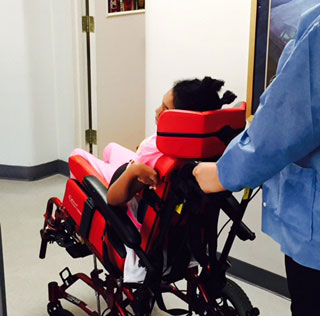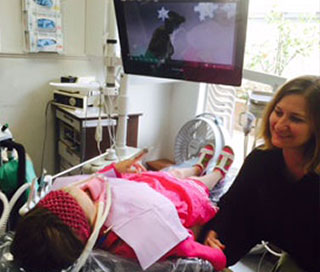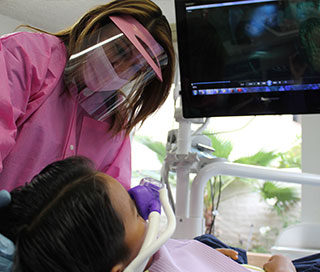SPECIAL NEEDS PATIENTS
Dr. Romero welcomes patients with difficult behavior and special needs. He has more than 20 years of experience treating patients with different conditions such as: ADHD, autism, trisomy 21 (Down syndrome), cerebral palsy, and other disabilities. Our goal for every patient is to make their dental visit as smooth as possible, treating them with genuine love, care, and respect.

SEDATION DENTISTRY
Sedation is a technique used to guide a child’s behavior during dental treatment. It involves a mild sedative which is administered orally or inhaled 5 minutes before the dental treatment, to help eliminate anxiety and relax your child, allowing us to provide the best possible dental care.
Inhale: Nitrous Oxide
Orally: Oral suspension of Midazolam HCL
Conscious Sedation with Nitrous Oxide (Inhale: Nitrous Oxide)
Some children are given nitrous oxide/oxygen, or what you may know as laughing gas, to relax them during their dental treatment. Nitrous oxide/oxygen is a blend of two gases, oxygen and nitrous oxide. Nitrous oxide/oxygen is given through a small breathing mask which is placed over the child’s nose, allowing them to relax, but without putting them to sleep. The American Academy of Pediatric Dentistry, recognizes this technique as a very safe, effective technique to use for treating children’s dental needs. The gas is mild and easily taken. Then with normal breathing, it is quickly eliminated from the body. It is also non-addictive. While inhaling nitrous oxide/oxygen, your child remains fully conscious and keeps all natural reflexes.
Prior to your appointment:
- Please inform us of any change to your child’s health and/or medical condition.
- Tell us about any respiratory condition that makes breathing through the nose difficult for your child. It may limit the effectiveness of the nitrous oxide/oxygen.
- Let us know if your child is taking any medication on the day of the appointment.


Conscious Sedation with Oral medicine (Oral suspension of Midazolam HCL)
Oral sedation may be indicated for apprehensive young children, patients who do not understand how to cope in a cooperative fashion or kids with special needs, who have a level of anxiety. It is used to calm your child and to reduce the anxiety or discomfort associated with dental treatments. Your child may be quite drowsy, and may even fall asleep, but they will not become unconscious.
The medicine we use is Midazolam HCL. The doctor will administer the medicine orally according to their weight. We will be happy to answer any questions you might have concerning the medicine we plan to give to your child.
Prior to your appointment:
- Please notify us of any change in your child’s health and/or medical condition. Do not bring your child for treatment with a fever, ear infection or cold. Should your child become ill, contact us to see if it is necessary to postpone the appointment.
- You must tell the doctor of any drugs that your child is currently taking and any drug reactions and/or change in medical history.
- Please dress your child in loose fitting, comfortable clothing.
- Please make sure that your child goes to the bathroom prior to arriving at the office.
- Your child should not have solid food for at least 6 hours prior to their sedation appointment and only clear liquids for up to 4 hours before the appointment.
- The child’s parent or legal guardian must remain at the room during the complete procedure.
- Please watch your child closely while the medication is taking effect. Hold them in your lap or keep them close to you. Do not let them “walk around.”
- Your child will act drowsy and may become slightly excited at first.
After the sedation appointment:
- Your child will be drowsy and will need to be monitored very closely. Keep your child away from areas of potential harm.
- If your child wants to sleep, place them on their side with their chin up. Wake your child every hour and encourage them to have something to drink in order to prevent dehydration. At first it is best to give your child sips of clear liquids to prevent nausea. The first meal should be light and easily digestible.
- If your child vomits, help them bend over and turn their head to the side to insure that they do not inhale the vomit.
- Because we use local anesthetic to numb your child’s mouth during the procedure, your child may have the tendency to bite or chew their lips, cheeks, and/or tongue and/or rub and scratch their face after treatment. Please observe your child carefully to prevent any injury to these areas.
- Please call our office (818-790 1160) for any questions or concerns that you might have.

